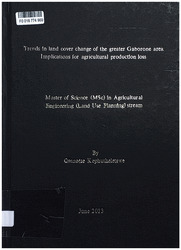| dc.description.abstract | Peri urban areas are contiguous to urban areas, they consist of a large population, and these are
regions where farming practice is in conflict with other economic activities. These activities
drive the changes in land cover that end up constricting the availability of natural resources for
human and livestock use, some of these changes pose environmental risks. Hence this study was
aimed at understanding the dynamics of land cover of the greater Gaborone area, and the impacts
these changes have on agricultural production. Land cover change of the greater Gaborone area
was analyzed using an orthophoto for the year 2002 and a satellite image from Google Earth map
(acquired 8 June 2010 through spot platform). Population data was also linked to land cover
changes. Yield data was used to estimate production loss consequent to land cover changes.
There has been a decline in the agricultural lands while the built environment increased.
Rangeland decreased from 698.12 km2 to 674.46 km2, arable lands from 137.34 km2 to 100.20
km2 whereas the buildup area increased from 81.09 km2 to 144.09 km2 from 2002 to 2OI0.Amid
these changes, 44.08 km* and 9.00 km* of rangeland and arable land respectively have been
converted to build up area resulting in yield losses of 980 LSU and 142 200 Kg of cereal.
Fiscally these losses amounted to P 101 738 70 and P 337 014 worth of livestock and cereal
respectively. During the same period, population in the study area has been increasing from 253
874, 356-251 in 2001, 2011 respectively and predictably 699 409 in 2035. Weighed against the
buildup area, these inhabitants necessitates 1.09 km2, 144.09 km2 and the predicted 282.54 km2
of build environment in the same years. From 2002 to 2010 most of the rangeland and arable
lands were converted to build up areas. The increase in buildup environment is undoubtedly at
the expense of rangeland and arable land. | en_US |

